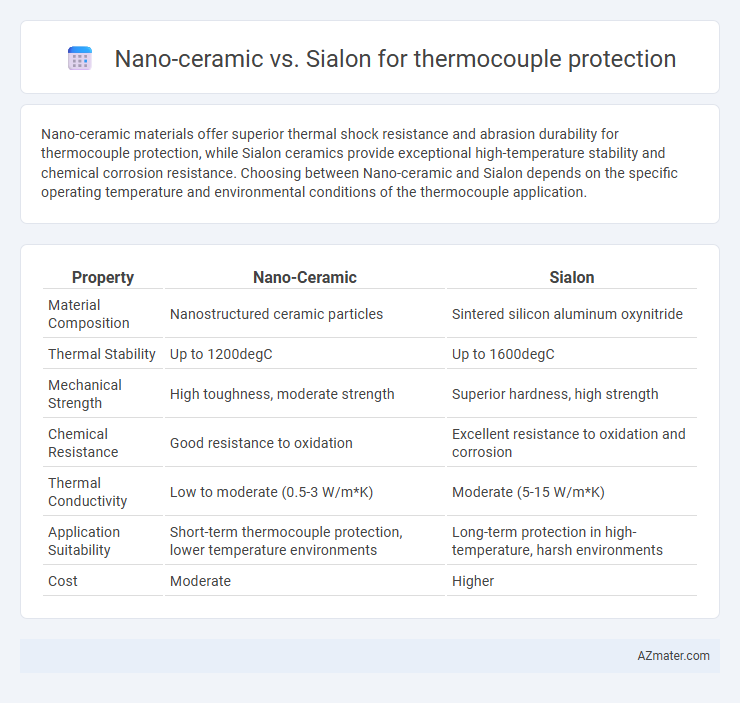Nano-ceramic materials offer superior thermal shock resistance and abrasion durability for thermocouple protection, while Sialon ceramics provide exceptional high-temperature stability and chemical corrosion resistance. Choosing between Nano-ceramic and Sialon depends on the specific operating temperature and environmental conditions of the thermocouple application.
Table of Comparison
| Property | Nano-Ceramic | Sialon |
|---|---|---|
| Material Composition | Nanostructured ceramic particles | Sintered silicon aluminum oxynitride |
| Thermal Stability | Up to 1200degC | Up to 1600degC |
| Mechanical Strength | High toughness, moderate strength | Superior hardness, high strength |
| Chemical Resistance | Good resistance to oxidation | Excellent resistance to oxidation and corrosion |
| Thermal Conductivity | Low to moderate (0.5-3 W/m*K) | Moderate (5-15 W/m*K) |
| Application Suitability | Short-term thermocouple protection, lower temperature environments | Long-term protection in high-temperature, harsh environments |
| Cost | Moderate | Higher |
Introduction to Thermocouple Protection Materials
Thermocouple protection materials are crucial for ensuring accurate temperature measurements in harsh industrial environments. Nano-ceramic coatings offer superior wear resistance and high-temperature stability, while Sialon ceramics provide excellent thermal shock resistance and mechanical strength. Selecting between nano-ceramic and Sialon depends on specific application demands such as temperature range, chemical exposure, and mechanical stress.
Overview of Nano-Ceramic Technology
Nano-ceramic technology employs ultra-fine ceramic particles to enhance thermal stability, mechanical strength, and corrosion resistance in thermocouple protection tubes. Unlike traditional Sialon ceramics, nano-ceramics offer superior microstructural uniformity and reduced grain size, leading to extended service life in high-temperature and chemically aggressive environments. This advancement improves thermocouple accuracy and durability, making nano-ceramic protection tubes ideal for precise temperature measurements in industrial applications.
Understanding Sialon: Composition and Properties
Sialon, a silicon-aluminum-oxygen-nitrogen ceramic, exhibits exceptional thermal stability and mechanical strength, making it ideal for thermocouple protection in high-temperature environments. Its unique composition combines the durability of silicon nitride with enhanced resistance to oxidation and thermal shock, outperforming traditional nano-ceramic coatings. These properties ensure accurate temperature measurement and extended thermocouple lifespan in demanding industrial applications.
Thermal Performance: Nano-Ceramic vs Sialon
Nano-ceramic materials exhibit superior thermal insulation properties with high-temperature stability up to 1200degC, making them effective for thermocouple protection in extreme environments. Sialon ceramics offer exceptional thermal shock resistance and maintain mechanical strength at temperatures exceeding 1400degC, ideal for continuous high-temperature monitoring. Both materials ensure reliable thermocouple operation, but Sialon's enhanced durability at elevated temperatures provides a critical advantage in harsh industrial applications.
Corrosion and Oxidation Resistance Comparison
Nano-ceramic coatings exhibit superior corrosion resistance due to their dense microstructure and chemical inertness, effectively protecting thermocouples in aggressive environments. Sialon ceramics provide excellent oxidation resistance, maintaining structural integrity at high temperatures up to 1600degC, which is critical for long-term thermocouple protection in oxidizing atmospheres. When comparing both, nano-ceramic coatings offer enhanced protection against corrosive agents, while Sialon's performance is more robust under extreme oxidative thermal conditions.
Mechanical Strength and Durability
Nano-ceramic coatings exhibit superior mechanical strength due to their nanoscale grain structure, enhancing resistance to wear and thermal shock in thermocouple protection. Sialon ceramics provide exceptional durability with high fracture toughness and oxidation resistance, making them ideal for harsh environments with fluctuating temperatures. When comparing, nano-ceramic materials offer improved hardness and abrasion resistance, while Sialon ensures long-term stability and mechanical integrity under extreme industrial conditions.
Cost-Effectiveness and Availability
Nano-ceramic thermocouple protection tubes offer superior cost-effectiveness due to lower raw material expenses and simpler manufacturing processes compared to Sialon, which is typically more expensive owing to its complex alloying elements and advanced fabrication techniques. Availability of nano-ceramic materials is generally higher in commercial markets, facilitating quicker procurement and replacement cycles, whereas Sialon, despite its excellent thermal and mechanical properties, may face limited availability as it is specialized and produced by fewer suppliers. The cost-effectiveness and broader accessibility of nano-ceramics make them a practical choice for thermocouple protection in applications requiring frequent maintenance and budget constraints.
Application Suitability in Various Industries
Nano-ceramic thermocouple protection tubes offer excellent thermal shock resistance and high-temperature stability, making them ideal for industries such as aerospace, automotive, and electronics where rapid temperature changes occur. Sialon protection tubes provide superior mechanical strength and corrosion resistance, favoring applications in metal processing, chemical manufacturing, and power generation where harsh environments and prolonged exposure to corrosive gases are common. Both materials enhance thermocouple durability, but industry-specific conditions dictate their optimal application suitability.
Maintenance and Lifespan Considerations
Nano-ceramic thermocouple protection sleeves exhibit superior resistance to thermal shock and corrosion, resulting in reduced maintenance frequency and longer operational lifespan compared to Sialon-based alternatives. Sialon materials, while offering excellent mechanical strength and chemical stability, may require more frequent inspections and replacements under harsh industrial conditions due to brittleness and potential microcracking. Selecting nano-ceramic protection enhances equipment durability and lowers downtime costs, optimizing maintenance schedules and extending the thermocouple's effective service life.
Conclusion: Choosing the Optimal Protection Material
Nano-ceramic materials offer superior thermal shock resistance and electrical insulation for thermocouple protection, making them ideal in high-temperature, rapid-cycling environments. Sialon ceramics provide exceptional mechanical strength and chemical stability, suitable for harsh industrial atmospheres with corrosive elements. Selecting between nano-ceramic and Sialon hinges on specific operating conditions such as temperature range, exposure to chemicals, and mechanical stress to optimize durability and sensor accuracy.

Infographic: Nano-ceramic vs Sialon for Thermocouple protection
 azmater.com
azmater.com